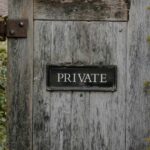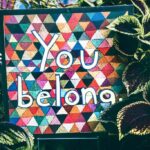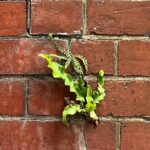
In the middle of the night, the Florida Department of Transportation (FDOT) painted over the Pride crosswalk outside the Pulse nightclub memorial, where 49 people were killed in a mass shooting in 2016. In response, protesters used chalk to restore the memorial’s rainbow colors—and then repainted it after rain washed the chalk away. FDOT quickly painted the crosswalk black again and posted signs reading “defacing roadway prohibited.” One man protested by placing chalk on the bottom of his shoe and walking across the crosswalk before being arrested; others were later detained after re-chalking the rainbow, writing “Right to free speech” on the pavement.
“We have to be willing to get messy, to be confrontational and fight like hell for what we want.”
This is one of hundreds of direct actions taking place across the country in protest of the spread of anti-LGBTQ+ laws: Activists have protested by staging die-ins and sit-ins at state and federal capitols, students have organized walkouts, and communities have held marches, rallies, and even “inject-ins,” where protesters publicly inject hormone replacement therapy (HRT) in defiance of care bans.
Many of these direct-action protests are rooted in a history of queer people resisting state violence. As LGBTQ+ people face escalating government persecution, the erasure of queer history, and efforts to pathologize and eradicate transgender people from public life, learning the resistance strategies used by LGBTQ elders is more important than ever.
“Queer history reminds us that norms can be very dangerous and you don’t get the norms changed by playing nice. We can’t just sit back and hope things will change,” Karma R. Chávez, professor of Mexican American and Latina/o Studies at the University of Texas at Austin, told NPQ. “We have to be willing to get messy, to be confrontational and fight like hell for what we want.”
“While sometimes necessary as a strategy, disappearing, or trying to make dominant power think you are worthy is never a way to win, but it is always a way to lose.”
The Necessary Fight for a Safer Future
In May 2025, police raided the Pittsburgh gay bar P Town during a drag show, ordering the performers and all 133 patrons to exit the building and wait outside. Similar police raids have occurred in the past year at gay bars in Seattle and Austin.
History reminds us that this isn’t new. In fact, police raids on queer spaces are a recurring tactic of control—from William Dorsey Swann’s drag ball in 1888 to the raids on New York’s Ariston Hotel Baths (1903), the infamous Stonewall Inn (1969), Toronto’s Body Politic office (1977), the mass “Operation Soap” bathhouse raids (1981), and the Warehouse Spa and Bath (2004).
While local police departments continue to weaponize “capacity” and “safety” regulations to target LGBTQ+ spaces, the federal government—through the Department of Justice—is echoing the interrogations and targeting during the Lavender Scare of the 1950s and 60s by investigating providers of gender-affirming care and school districts that support trans students. Many institutions have complied over the potential loss of funding or further scrutiny, effectively abandoning trans communities.
Yet again, history shows that compliance only emboldens further repression. For example, early homophile groups like the Mattachine Society and Daughters of Bilitis pursued respectability and assimilation, yet were still surveilled by the FBI, targeted by police, and their members denied legal protections.
Queer history shows that state violence isn’t always active policing; it’s also inaction that exposes how little the government values queer lives.
“While sometimes necessary as a strategy, disappearing, or trying to make dominant power think you are worthy is never a way to win, but it is always a way to lose,” said Eric Stanley, associate professor in the Department of Gender and Women’s Studies at the University of California, Berkeley, in an interview with NPQ.
So many LGBTQ+ people from the past fought back because they had to if they wanted to fight for a safer future for queer people. Each police raid—and other forms of state violence—inspired a myriad of resistance tactics that we can learn from. They organized “sip-ins” at bars, “kiss-ins” and “Nights Out,” zaps (noisy but nonviolent confrontations with public officials), the first Pride marches, and waves of community newsletters and magazines. Activists blocked roads, pressed ink-covered handprints into buildings and pavement, organized self-defense trainings, and provided food and shelter to those who needed it.
Queer history shows that state violence isn’t always active policing; it’s also inaction that exposes how little the government values queer lives. For example, when the federal government ignored the AIDS crisis—effectively letting gay people die—queer communities refused to disappear. In the face of that desertion, organizers changed their tactics. Some demanded government action, while others built networks of community care and built the contemporary harm reduction movement.
“Right now, I’m thinking about when ACT UP protested at the CDC and at the International AIDS conferences in Montreal and San Francisco in ’89 and ’91 in order to challenge their exclusion and the woeful inaction of the scientists there,” Chávez, said. “Their direct action was instrumental in getting them a seat at the table and directly changing the way science was done.”
The Same Battles Today as Before
In many ways, we’re fighting the same battles today. Take, for instance, how as health secretary, Robert F. Kennedy, Jr. has pulled millions in funding from hundreds of organizations, including those supporting LGBTQ+ health research, and queer communities are once again protesting the National Institutes of Health (NIH).
“It’s hard not to locate that in queer history,” Chávez said.
While the LGBTQ+ movement has much to learn from past successful tactics—especially as today’s struggles echo earlier battles—Chávez also reminds us that queer history is equally important for understanding and avoiding past mistakes.
Hugh Ryan, historian and author of The Women’s House of Detention: A Queer History of a Forgotten Prison, told NPQ that one of the most valuable ways to think about protests is to study which tactics proved effective and which did not.
He points to the House of Detention—a women’s prison in Greenwich Village that operated for most of the 20th century—as a powerful case study. By the mid-1960s through the late 1970s, the prison held several people who were or would become prominent figures in queer, feminist, and revolutionary movements. Two, in particular, stand out: Angela Davis and Andrea Dworkin.
Dworkin was arrested at 18 for protesting the Vietnam War and announced a hunger strike inside the prison with several friends. While the action drew attention, it ultimately went nowhere, Ryan explained. It lacked a clear plan, strong connections with others inside, or concrete demands that could be met.
A few years later, however, Angela Davis also announced a hunger strike. That time, Ryan explained, it was coordinated with other incarcerated people, rooted in solidarity and collective planning. Crucially, Davis articulated specific conditions that needed to be met for the strike to end. The combination of community support, solidarity within the prison, and a winnable set of demands made her action effective.
“And so, when I think about this,” Ryan said, “I think a lot about what kind of activism now we can be doing that invites people in.”
Queer Collectives and the Fights Against Oppression
While some homophile organizations predated Stonewall, many of the most remembered (and most radical) LGBTQ+ groups—including the Lavender Menace, the Gay Liberation Front (GLF), Lavender Panthers, Queer Nation, and the Street Transvestite Action Revolutionaries (STAR)—emerged in its aftermath. Many of these groups did not only fight for queer liberation: They built solidarity with movements against the Vietnam War, for Black liberation, women’s liberation, socialism, communism, anarchism, labor rights, housing justice, and global struggles against apartheid.
“My advice is always look as far left as you can, metaphorically, and see what you can learn from them,” Stanley said. “Going toward the center will offer you nothing but despair.”
For instance, the GLF was impactful because it built alliances with the Black Panthers, the Young Lords, radical lesbians, and Youth Against War and Fascism. In August 1969, their very first action was a protest at the House of Detention, organized in solidarity with Black Panther members who were being held there.
The GLF was one of many radical queer collectives that recognized the interconnectedness of oppression and embraced an inherently anti-statist politics. Yet, Ryan explained, “At the end of the first wave of the AIDS crisis, the movement’s focus shifted toward assimilation—winning key legal victories, securing formal equality, and gaining the ‘right’ to be queer on mainstream television and in everyday public life.”
This strategic shift from a focus on grassroots direct action to legal reforms—such as anti-discrimination laws, hate crime statutes, and electoral politics—siloed the LGBTQ+ movement from broader struggles and sanitized its radical, liberatory roots in favor of assimilation. While these strategies secured some civil rights victories, they often excluded those deemed not “respectable” enough to benefit.
The Enduring Power of Queer Organizing and Community
Today, as the Supreme Court and the Trump administration further restrict the LGBTQ+ movement’s ability to pursue meaningful change through the courts, the limits of assimilatory politics are increasingly becoming clear.
“We have to give up hope in our elected officials and electoral politics. We have to rely on us to make the change we want. We also need to take the lead of those most impacted,” Chávez said. “Queer liberation didn’t always do this; but it is a red thread throughout the history. We need to listen to each other’s experiences and do the hard work of making the connections and build the movements that will save us all.”
As a result, many LGBTQ+ groups are reassessing their tactics, drawing from earlier generations who organized against police violence, state repression, and systemic erasure.
“I think the emphasis on the spectacular (die-ins, kiss-ins, disruptions) is especially salient right now. I also think the deeply anti-imperialist and, dare I say, intersectional, approach of prior queer groups like Gay Liberation Front is also necessary right now,” Chávez told NPQ. “I also am always taken by the fact that ACT UP allowed people to experiment. If you had an idea and it was about ending AIDS, you could do it. We need a million experiments right now.”
This may require rethinking the nonprofit model as a way to enact change, especially as federal attacks on funding and nonprofit autonomy intensify.
“The most effective groups grow out of people coming together to talk, read, and think critically about the issues they face. From consciousness-raising circles to study groups, that process creates real power—not just by gathering around shared assumptions, but by developing ideas collectively and testing how they resonate in the world,” Ryan advocated. “That’s how movements like ACT UP, Grand Fury, the Combahee River Collective, and STAR began: small groups of people hashing out ideas together, then organizing outward from there.”
Queer history makes clear that those in power have long been terrified of queer joy. For centuries, they sought to criminalize, pathologize, and erase LGBTQ+ people. Yet the attacks on LGBTQ+ spaces, queer lives, and queer history also underscore the enduring power of queer organizing and community. Our ancestors have always resisted—and now, more than ever, we must learn from both their victories and their setbacks.













